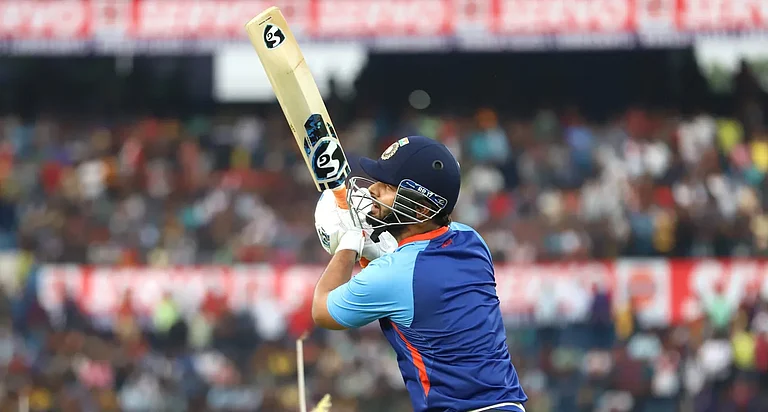CAPTIVITY killed his spirit. And freedom will come only through death. It's an ironic twist of fate for 11-year-old Vrinda, the African lion rescued on February 28 this year by the UP forest department officials from the Veena Kamal Golden (mobile) Zoo. Come November 15, because of his diseased state, Vrinda will be put to sleep .
Vrinda—christened thus by forest officials since he was recovered in Vrindavan—is a living example of the treatment meted out to wild animals. Confined for nearly 10 years in a diminutive cage (185 cm x 175 cm x 125cm) at the mobile zoo, the lion developed hunched vertebrae. This affected and deformed his entire spinal cord, which has hampered his neuro-muscular coordination. He wobbles as he moves and his wounds continue to bleed due to repeated falls. A victim of severe malnutrition, Vrinda's immunity has also diminished considerably.
The lion is among 98 animals recovered from three other such mobile zoos—the Pardesi Touring Mini Zoo and Bharatiya Chiriyaghar in Calcutta and the Heera Golden Zoo in Jabalpur—in a campaign launched by the UP forest department officials against mobile zoos. The pathetic story repeats itself for most of the rescued animals, presently housed in makeshift cages at the Lucknow Zoo. Lalita, a five-year-old lioness recovered from the Heera Golden Zoo, has turned blind due to cataract. Dr Utkarsh Shukla, the veterinarian posted at the Lucknow zoo, spent all of three days in an operation to extract two huge balls of Lalita's hair that had led to a 5-ft long blockage in her intestines. Sheer boredom of living in crude and tiny confines, explains Dr Shukla, drives these animals into acquiring odd behavioural patterns. Lalita developed the habit of licking herself throughout the day and in the process consume her own hair. The rescued hyenas have also developed the habit and the consequent stomach ailments.
Vrinda's other companions have fared no better. Champakali, a rhesus monkey, pelts stones at passers-by to kill boredom while her next-door neighbour, another monkey, overcomes monotony by rattling his cage as long as his energy allows it. The four crocodiles continue to shed tears, this time with genuine reason. Lying in an iron trough of water topped with a thick mesh, they do not even have room to change position. The troughs are smaller than the length of the crocodiles.
It's only smaller animals like the monkeys, porcupines, weasels and civet cats who're relatively better off. Because of their size, they manage some free movement in the tiny cages they've been con-fined in. It's the bigger and endangered species that continue to give the UP wildlife authorities sleepless nights.
AND shortage of funds and manpower is doing little to improve things. "We lack the funds to build proper, spacious cages to suit the needs of these animals," says Lucknow zoo director G.P. Sharma. Chief conservator of forests and chief wildlife warden R.L. Singh has sought an additional Rs 12.5 lakh from the Union government for the extra expenditure incurred on the food, upkeep and medicine of these animals. Another Rs 15-20 lakh would be required for constructing proper housing for the 98 rescued animals.
Vrinda's food and treatment alone cost Rs 10,000 a month. The lion is fed several vitamins. A mixture of sulphur, antiseptics and a sealing lotion is sprayed directly on its wounds. "But no sooner does one wound heal than another appears," laments vet Dr Shukla. Which is why the authorities have had to take the difficult decision of going in for mercy killing and relieving the lion of its miseries.
"It's one of the most unpleasant decisions of my life," says CCF Singh. The issue was discussed in detail at a meeting of forest secretaries and chief conservators of forests in the capital on October 22. It was also taken up at the October 26 meeting of the Indian Wildlife Council where it was decided that euthanasia, a zoo management technique the world over, seemed the only answer to the situation. Accordingly, wildlife preservation director S.C. Sharma, who is also member secretary of the Central Zoo Authority, recommended the constitution of a panel of three doctors, including the Lucknow zoo vet, for a final medical verdict.
The Wildlife (Protection) Act of 1972 does not clearly provide for euthanasia. The only reference to killing of animals is provided under Clause 11(a) of the act which reads: "The CCF may, if he is satisfied that any wild animal specified in Schedule-I, has become dangerous to human life or is so disabled or diseased as to be beyond recovery...permit any person to hunt such animal...". Though this provision deals with hunting of dangerous or disabled animals only in the wild, Singh believes it can also be applied in Vrinda's case. Vrinda will be given a heavy dose of tranquiliser but will not be injected with Revivon, so that he cannot revive and instead die 'painlessly', experts say.
But while euthanasia may be valid technically, Singh has been besieged by phone calls from animal lovers ever since he broke the news of his mercy killing. While most enquire about the animal's welfare, "there are others who staunchly believe in the 'karma' philosophy." They tell Singh that the lion should be allowed to die a natural death lest he has to complete the same sufferings in his next birth.
But whatever be the public reaction, a contemplative Singh seems to be left with little alternative. The mercy killing would at least allow Vrinda to die in dignity. As of now he paints a pathetic picture as he lies awaiting his death warrant. There is little of the Lion King left in the emaciated beast.























